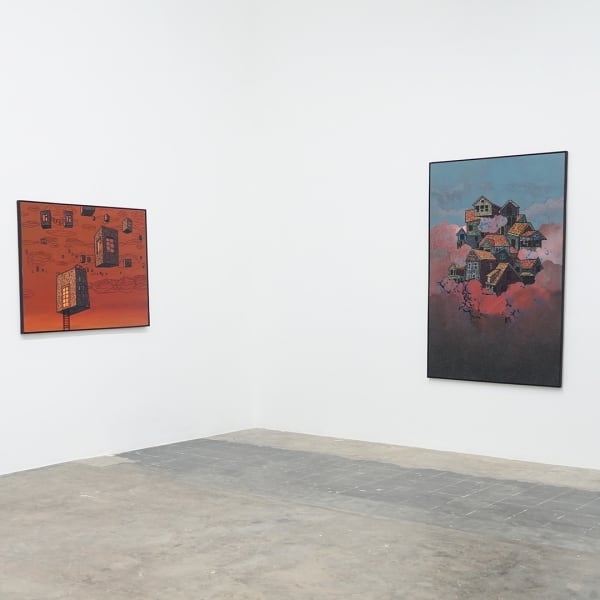Dreamscape: Chathurika Jayani
Chathurika Jayani’s Dreamscapes is an exhibition of paintings that consists of heavy set colours and textures depicting a fantastical urban situation. While the artist’s work explores themes of urbanism and city building, she painted structures, which could be described as ahistorical, often referring to the omnipresent and corrugated tiling sheets found on buildings across the country. Her approach is a conceptual one, where the architectural subject is observed and painted from several perspectives, including the literal and the abstract. Through these conceptual structures, Jayani participates in a global conversation about the current state of architecture and urban planning. For example, one may travel to several cities in different countries to find the same styles and types of building, sometimes produced by the same architectural studios. In some cases, it would make little difference which country one was to find themselves in; while spectacular in nature, the experience of these places may be all too similar.
Underlying the majority of these works is a foreboding reflection on the relationship between urbanism and the environment. Whereas the idea of floating cities in the sky, spurred on by the speed of engineering and technology, maybe awe-inspiring, Jayani’s paintings question the moral conduct of these extensive construction projects. What are the terms of their legacy? What do they choose to leave behind, leave out altogether, and take with them? Dreamscapes muses on the tension between utopian design and dystopian reality; are the constant attempts of urban expansion a pure fantasy, devoid of being grounded and respectful about the difference in the realities of the poor and the privileged? These paintings question the historical validity of contemporary construction projects, as they often displace pre-existing communities and their neighborhoods, with inadequate compensation. Traditionally, classical Sri Lankan architecture has its roots in building according to the flow of the natural landscape. As her structures bathe in blood-red skies, and turbulent rainclouds toss and turn the buildings according to their whim, the artist points to deeper consequences, especially when it comes to society’s lack of alignment to the forces of nature. Her paintings suggest an impending climate crisis; are those at the top of the hierarchy ignorant, or are they building exclusive spaces higher than ever simply in order to escape?
Jayani’s paintings touch upon the tenacity of power and authority in this exhibition, as some buildings appear to be more equal than others. The architectural facades in her paintings also include playful geometries that reflect the often-vivid nature of proposed redevelopment projects. Her conceptual buildings invite the viewer to engage in multiple readings as these colourful conglomerates tend to hover above and mask the vibrant but darkly lit cityscapes and their densely packed communities on the ground below. The majority of Jayani’s inhabitants in her Dreamscapes seem tobe caught between the turbulent forces of nature and the iron fist of political authority behind these building projects. Her work asks if the potential of political power can measure up to the forces of nature. In addition to this, the nature of labor comes into view as not only the occupants of these floating and dreamlike habitations appear to be absent, perhaps contained within them, but so do their builders. In one painting, a white cube of composite geometries hovers above a wasteland of discarded buildings. In another, a colourful construct sits upon a blackened landscape. With nature appearing to be remade in these instances, and natural landscapes subsumed by the excess of industrial production and urban living, her paintings point to a contradiction within the system. Not only are these whitewashed aspirations indifferent to the realities of class divide and environmental degradation, but instead of providing a long-lasting solution, there continues to exist a falsity of aspiration where privilege and displacement are two sides of the same coin. It is those with less privilege often caught between power struggles, as humanity’s fraught relationship with itself continues.
The sculptural quality of these paintings stands out in particular as Jayani asserts her handling of unconventional and alternative materials. Her impasto style complements the use of the corrugated board, a recurring design motif found over a range of local neighborhoods and communities, to dramatic effect. Jayani’s illustrative style is further supported by an intensive application of stitchwork, which helps underscore the conceptual and thematic dimensions of her work. As the cloud formations move between being abstractions and reality, they expose a contradiction in the indifference of the floating structures to the reality of the ground below: they rest on either fabricated or precarious realities, of which the seams may come undone or be swept away at any moment. Jayani’s work also passes into complete geometric abstraction, successfully dismantling and reconstructing the structural and philosophical integrities of her architectural subjects. However, an interesting twist emerges as while the majority of the showcase focuses on the physical attributes of the buildings, the primary focus rests on their states of being. Floating, moving, turning, tumbling, these structures appear to be in a constant state of flux. The two sole appearances of human figures in this exhibition appear to conjure up these architectural spaces from the depths of their imaginations. Jayani suggests that these visions still hold the promise of a utopian paradise made possible by the best facets and qualities of human inspiration. Dreamscapes highlight the criteria by which we assess our ways of living fairly and ask if nature ultimately will have to be the great equalizer, or if humanity can justly assume the role itself.









